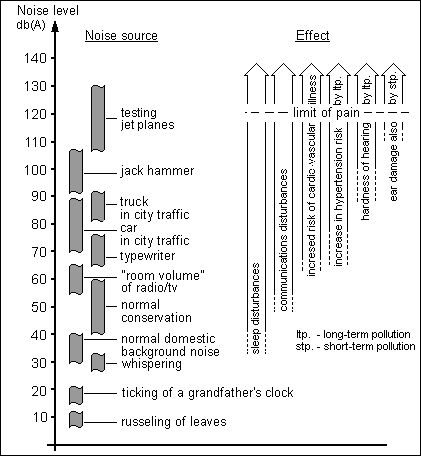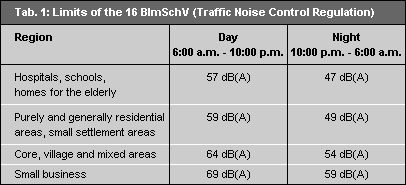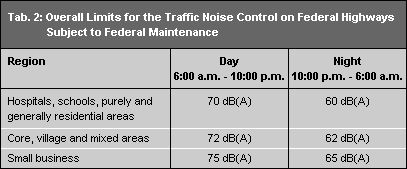In Berlin there are currently 1.28 million motor vehicles registered. Not only does their use lead to enormous noise pollution in the road areas but, also both day and night, permanently detract from the living and occupational quality of the buildings and land located near the main network road. The effects are particularly grave in streets with traffic volumes exceeding 50,000 motor vehicles per 24 hour period. (e.g. Sachsendamm, Schöneberger Ufer, Frankfurter Allee, Gruner Strasse and See Strasse). Although these streets comprise only 1.7 % of the total length of the approx. 1,200 km long primary road network (main network), they carry approx. 19 % of all vehicle traffic.
Technical construction modifications to motor vehicles have resulted in significant reductions in the level of motor noise in the past years. In 1983, the EC’s permissible noise emission level for motor vehicles lay at about 10 dB above today’s limit, i.e. 10 vehicles of the current models are – from the standpoint of motor noise – not louder than one which was registered in 1983.
Despite that Berlin’s streets have not become any quieter. The reason for this is the enormous increase in motor vehicle traffic and the fact that virtually no progress has been made in reducing the amount of noise from tires and road surfaces. The introduction of “30 km / hour” zones for 70 % of all roads has resulted in a reduction of traffic noise but, noise in the main traffic arteries has increased. Noticeable reductions can also be found for the sections of the tram network where the track beds have been renewed.
As a whole it is the noise from the primary road network – compared with other sources such as rail and air traffic, industry and small business as well as sports and leisure noise which because of both its extent and the number of affected persons – presents the most problematic pollution.
Noise is to be understood as every kind of sound which is undesired, disturbs, or irritates, and which detracts from physical, psychological, or social well-being.
Depending on the duration and intensity, noise can lead to a number of problems. Some of these are among others:
- reduction of the ability to concentrate,
- communications disturbances,
- disturbances to sleep and recreation,
- negative influences on vegetative nervous system (high blood pressure, cardio-vascular-complaints, disturbances in digestive organs),
- obstructions resp. damage to hearing,
- increased risk of cardio-vascular illnesses.



